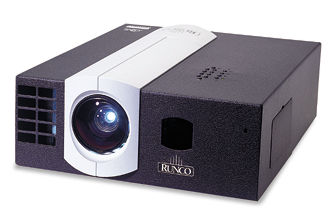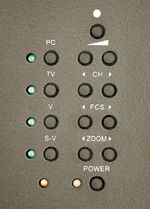Runco Reflection VX-101c Front-Projection System

The Reflection VX-101c is such a system, marrying the VX-101c projector—a DLP (Digital Light Processing) display—and Runco's VHD (Virtual High Definition) video processor/controller. The display comes in a black metal housing and hides one of Texas Instruments' DMD (digital micro-mirror device) chips inside. The DMD uses an 800:600 array of microscopic mirrors and a light bulb to create a picture.
Even though the panel has a 4:3 shape, the system can be set up for either 1.33 (4:3) or 1.78 (16:9) screens. On either screen, the VHD controller changes all the aspect ratios to accommodate anamorphic, nonanamorphic, and full (1.33) images. With a 1.33 screen, the projector uses the entire 800:600 DMD panel for 1.33 images. With 1.78 images on either a 1.33 or 1.78 screen, the display uses the middle two-thirds (800:450) of the panel to create the picture. If you use a 1.78-shaped screen, the projector will still spill some light above and below the image. Consider adding additional black fabric to absorb this light. No one would label this a high-definition display. You may even think that this is far too little resolution for a $10,000 NTSC product, especially since the Sony LCD projector (see review in this issue) has a 1,355:768 resolution in the 1.78 mode and costs $2,000 less. Then again, typical video (NTSC) can only be effectively upconverted to 480p. Any scaling done beyond that point is just creating redundant information to fill in space. This system only falls a hair shy of NTSC's limit and doesn't suffer because of it.
 Part of the reason for this is a black box that sits only one-rack-unit high. The VHD controller contains all the inputs, outputs, aspect-ratio control, picture adjustments, and so on. With one each of composite, y/c, and component inputs and a VGA-type RGB passthrough, this system should be able to handle most sources. Only the passthrough can accept digital television signals, although our sample was limited in this respect. The controller's high-quality deinterlacing (with 3:2 pulldown recognition) and scaling functions convert all NTSC images to match the display's native resolution, depending on the aspect ratio. In addition, the processor makes adjustments to the image to compensate for the projector's gamma (which I'll explain later). The controller truly complements the display.
Part of the reason for this is a black box that sits only one-rack-unit high. The VHD controller contains all the inputs, outputs, aspect-ratio control, picture adjustments, and so on. With one each of composite, y/c, and component inputs and a VGA-type RGB passthrough, this system should be able to handle most sources. Only the passthrough can accept digital television signals, although our sample was limited in this respect. The controller's high-quality deinterlacing (with 3:2 pulldown recognition) and scaling functions convert all NTSC images to match the display's native resolution, depending on the aspect ratio. In addition, the processor makes adjustments to the image to compensate for the projector's gamma (which I'll explain later). The controller truly complements the display.
The only feature lacking on our sample was the ability to easily and effectively handle DTV signals. While the passthrough will accept high-definition RGB signals, the projector has difficulty figuring them out. As of this writing, Runco has nearly finished a field-replaceable upgrade that would put all DTV conversions and aspect-ratio control within the VHD processor. This upgrade should accept 1080i, 720p, and even 540p and would convert them to the panel's native display rate. Check back with us here, or on our Website, for an update.
![]() Before you can set up the controller, though, you have to install the projector. As if DLP projectors weren't easy enough to install, this model includes a remote-controlled motorized lens. You can set the focus or zoom from the confines of your easy chair. The projector's remote is annoying but fortunately is not needed after the initial installation; the controller will handle everything else. The projector's clever cabinet design hides all wiring by routing it through its base; however, the cabinet's tight confines make it difficult to actually connect the wires. Fortunately, there are only two wires to connect: the controller's umbilical adapter and a grounded power cord. The umbilical connector is about 2 feet long and is terminated with five BNC connectors for video and one RJ-11 (phone-type) connector. Run your five-wire video and six-wire phone cable from the equipment rack to the projector, and you're set.
Before you can set up the controller, though, you have to install the projector. As if DLP projectors weren't easy enough to install, this model includes a remote-controlled motorized lens. You can set the focus or zoom from the confines of your easy chair. The projector's remote is annoying but fortunately is not needed after the initial installation; the controller will handle everything else. The projector's clever cabinet design hides all wiring by routing it through its base; however, the cabinet's tight confines make it difficult to actually connect the wires. Fortunately, there are only two wires to connect: the controller's umbilical adapter and a grounded power cord. The umbilical connector is about 2 feet long and is terminated with five BNC connectors for video and one RJ-11 (phone-type) connector. Run your five-wire video and six-wire phone cable from the equipment rack to the projector, and you're set.
The controller uses the phone cord to communicate with the projector; the processor takes over all operations once the projector is installed and focused (except, as I mentioned, for DTV sources). Both an egg-shaped, handheld IR remote and RS-232 computer port control the processor. The latter option, used with Crestron- or AMX-type control systems, is a far better choice. The projector's remote appears simple. It has only seven buttons (power, menu, enter, and four unlabeled arrows), but accessing menu functions is relatively slow. Also, IR-based universal-remote owners will find no direct-access control of source or screen shape. In fact, only dumb luck (or reading the manual) will tell you that the left and right arrows can cycle through inputs and that the up and down arrows can cycle through aspect ratios. This may not be elegant, but it'll do in a pinch. Fortunately, though, you can toggle the projector's power with the press of a single button, something not possible on competing models.




























































